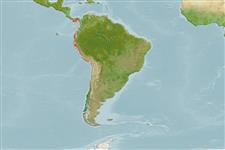Teleostei (teleosts) >
Eupercaria/misc (Various families in series Eupercaria) >
Sciaenidae (Drums or croakers)
Etymology: Paralonchurus: Greek, para = the side of + Greek, logchos = lance + Greek, oura = tail (Ref. 45335).
More on author: Steindachner.
Environment: milieu / climate zone / depth range / distribution range
Ecology
Marine; demersal; depth range 10 - ? m. Tropical; 9°N - 20°S, 82°W - 70°W (Ref. 112843)
Eastern Pacific: Panama to northern Chile.
Length at first maturity / Size / Weight / Age
Maturity: Lm ?, range 24 - ? cm
Max length : 51.0 cm TL male/unsexed; (Ref. 55763); common length : 30.0 cm TL male/unsexed; (Ref. 55763)
Short description
Identification keys | Morphology | Morphometrics
Body elongate, moderately compressed, with an arched dorsal profile; snout prominent; mouth small and inferior; lower jaw enclosed by upper; chin with 5 pores and 12 to 15 pairs of small barbels; edge of preopercle smooth; lower branch of first gill arch with 10 to 14 gill rakers; body uniformly dark and silvery; flanks with 7 or 8 indistinct bars; fins dark (Ref. 55763).
Found along sandy coasts and in bays (Ref. 9118). Feeds mainly on worms and other benthic invertebrates (Ref. 9118). Common in local markets (Ref. 9118).
Life cycle and mating behavior
Maturity | Reproduction | Spawning | Eggs | Fecundity | Larvae
Chao, L.N., 1995. Sciaenidae. Corvinas, barbiches, bombaches, corvinatas, corvinetas, corvinillas, lambes, pescadillas, roncachos, verrugatos. p. 1427-1518. In W. Fischer, F. Krupp, W. Schneider, C. Sommer, K.E. Carpenter and V. Niem (eds.) Guia FAO para identificacion de especies para los fines de la pesca. Pacifico Centro-oriental. 3 volumes. 1813 p. (Ref. 9118)
IUCN Red List Status (Ref. 130435: Version 2024-2)
Threat to humans
Harmless
Human uses
Fisheries: commercial; aquarium: commercial
Tools
Special reports
Download XML
Internet sources
Estimates based on models
Preferred temperature (Ref.
123201): 17 - 22.8, mean 20.4 °C (based on 14 cells).
Phylogenetic diversity index (Ref.
82804): PD
50 = 0.5156 [Uniqueness, from 0.5 = low to 2.0 = high].
Bayesian length-weight: a=0.00759 (0.00472 - 0.01218), b=3.11 (2.98 - 3.24), in cm total length, based on LWR estimates for this species & (Sub)family-body (Ref.
93245).
Trophic level (Ref.
69278): 2.2 ±0.1 se; based on diet studies.
Resilience (Ref.
120179): Medium, minimum population doubling time 1.4 - 4.4 years (Assuming tm=2).
Fishing Vulnerability (Ref.
59153): Moderate vulnerability (40 of 100).
Climate Vulnerability (Ref.
125649): Very high vulnerability (80 of 100).
Nutrients (Ref.
124155): Calcium = 134 [77, 299] mg/100g; Iron = 1.13 [0.57, 2.08] mg/100g; Protein = 18.4 [17.1, 19.6] %; Omega3 = 0.175 [0.089, 0.309] g/100g; Selenium = 60 [31, 128] μg/100g; VitaminA = 14 [4, 47] μg/100g; Zinc = 1.42 [0.99, 2.12] mg/100g (wet weight);
